For a healthy life, a person needs fresh air, which provides oxygenation of all body tissues thanks to the work of the respiratory system. The lungs receive the inhaled air mass and provide exhalation.
The maximum volume of the gas mixture that has passed through the lungs (inhalation / exhalation) is called the vital capacity of the lungs (VC). In medicine, there are norms for this important indicator in women, men and children. If the value decreases below a certain limit, health problems appear.
Record content:
-
1 What is lung volume
- 1.1 Lung volume parameters
- 1.2 How much oxygen does the lungs hold?
- 1.3 Lung volume
-
2 How to measure lung volume
- 2.1 How to measure at home
- 3 The main causes of violation of VC
- 4 Lung vital capacity video
What is lung volume
The lungs are the basis of the respiratory system, they provide saturation with a gas mixture (oxygen with carbon dioxide) of all organs (brain, heart and others). This is a paired organ located in the space of the chest to the right and left.
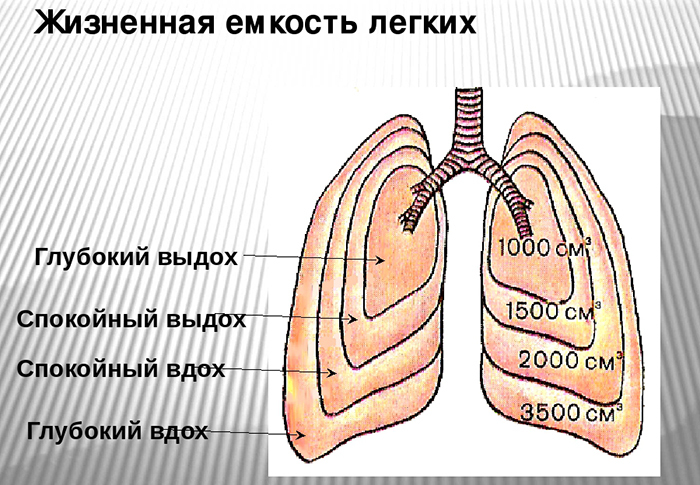
Each lung consists of several lobes - there are 3 in the right, and 2 chambers in the left. Each pulmonary lobe is connected to the bronchi by means of "branches" that adjoin small segments in the structure of the right and left chambers.
At the ends of the "branches" there are alveolar membranes, which interact with the capillaries due to their thin walls. As a result of the diffuse process, the blood is enriched with oxygen.
The respiratory system includes not only the lungs, but also the trachea (windpipe) and the bronchial tree (bronchi). The interior of these organs is lined with ciliary epithelium of the mucous membrane.
If an inflammatory process begins in the mucous membrane due to a disease, the patency of the airways is sharply reduced (obstruction).
The volume of the lungs (OB) is the total amount of air masses passing through the organs of the respiratory system during one respiratory cycle. Checking this parameter is important to understand how much the internal organs and tissues are saturated (saturation process) with oxygen. Indeed, with a constant lack of it, pathologies of various organs develop, dangerous with serious consequences.
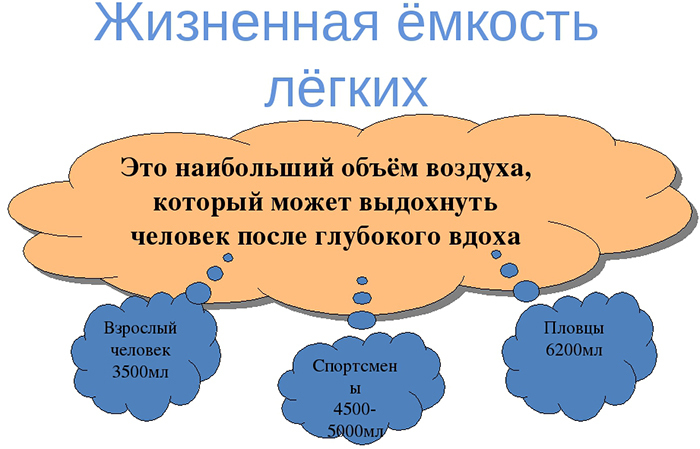
The value of OL is influenced by many indicators, but among the main ones are the following individual qualities:
- Body features and body weight. With thinness and high growth, in most cases, the VC indicator is higher when compared with short and stocky people. However, obesity contributes to a decrease in the parameter by more than 10%.
- Age and health status. The fact of physiological aging of the body is accompanied by a decrease in lung capacity. Its decrease provokes not only exacerbation of chronic pathologies, but even cured respiratory diseases.
- Accommodations. If we compare the OL of people living in mountainous and flat areas, it turns out that the capacity of the lung chambers of the mountaineers is much higher. The reason is associated with the high concentration of oxygen in the gas mixture of air.
VC (norm) in women depends not only on physique and age, but also on weight. Indeed, in hypersthenic women, the lungs are usually smaller, especially if they smoke and live in an area located at sea level.
During pregnancy, women often experience attacks of dizziness from a lack of oxygen in the blood. The reason is due to an increase in the size of the uterus, which leads to compression of internal organs, including the diaphragmatic muscle, and a decrease in the volume of incoming air masses.

Due to a decrease in the reserve amount of air on exhalation, there is a need to increase the inhaled air, but there are no cardinal changes in the total respiratory capacity.
Lung volume parameters
In a calm state, a person does not inhale or exhale to the maximum.
Therefore, for a medical assessment of OB, it is necessary to obtain 4 main indicators of the functioning of the respiratory system:
| Volume name | Average value, cm3 | Parameter decoding | Russian / English notation | |
| Respiratory | 500 | The amount of gas mixture (air) required to breathe in a calm mode, when a person breathes evenly. | BEFORE | TV |
| Reserve (on inspiration) | 1500 | An additional breath of air, which is possible after an active inhalation. | ROVD | IRV |
| Reserve (on exhalation) | 1500 | An additional portion of air still available for exhalation after active exhalation. | Rovyd | ERV |
| Residual | not measurable | Residual (functional) volume of air retained in the lungs after active exhalation and removal of the main DO. | OO | RV |
Measurements of the values of the listed parameters will be needed by the doctor to calculate the main indicators of OB:
- OEL / TLC parameter. The total lung capacity is obtained by summing the 4 measured values described above. This is the volume of air mass in the pulmonary chambers.
- Parameter YEL / VC. The value of the vital capacity of the lungs is calculated as the sum of the reserve RO during inspiration and expiration plus the value of DO. Norm - within 3500 cm3.
- FOEL / FRC parameter. The value of the functional residual capacity is obtained by summing the RO during calm expiration and RO.
- Parameter IC. To determine the inspiratory capacity (the number of air masses that filled the lung capacity during one inhalation), add the values of TO and RVD.
The term "vital capacity of the lungs" denotes the volume of the gas mixture VC, which the chambers of the lungs can accommodate during their maximum filling after active inhalation.
In the mode of calm and shallow breathing, a certain amount of air masses remains in the lung cavity. From this air reserve, an indicator of the functional residual capacity is formed, it is denoted by the abbreviation FOEL.
How much oxygen does the lungs hold?
For breathing, the average adult takes 16-20 breaths / minute, which is approximately one liter for 10 seconds. At the same time, the capacity of the lungs for representatives of different sexes is not the same, for men it is 4-5 liters, and for women this parameter is 3-4 liters.
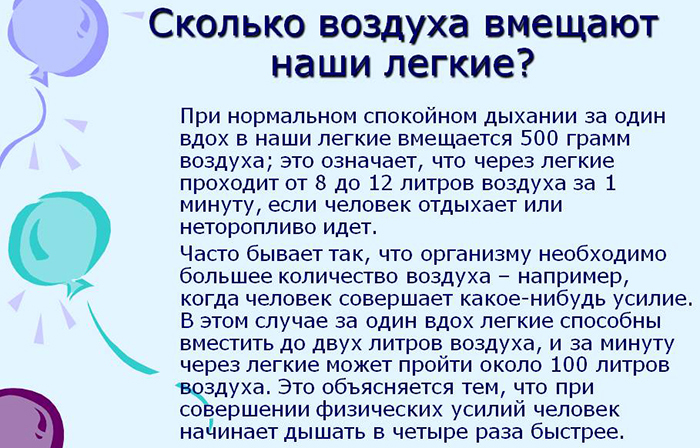
VC (norm) in women is usually lower, but active sports activities contribute to an increase in lung volume. This leads to the demonstration of data uncharacteristic for the fairer sex. Sports training helps to more efficiently use the supplied oxygen due to the strengthened muscle frame and enhanced breathing capacity of the diaphragm.
According to pulmonologists, OB increases not only due to the high growth of a non-smoker. Lung capacity is also affected by being a male with an asthenic physique.
Under the influence of regularly high physical exertion, the size of the VC can reach 6.2 liters. And not only among athletes (swimmers), but also among musicians using wind instruments, as well as singers.
Lung volume
In medicine, there are physiological norms for OB for patients of different sexes.
They are calculated according to the formulas given in the table, taking into account the parameters measured during the diagnosis:
| Types of volumes | Average value in liters | How is it calculated | |
| Female | Male gender | ||
| VC indicator | 3,1 | 4,8 | ROVD + DO + ROVID |
| Air capacity indicator | 2,4 | 3,8 | ROVD + DO |
| Parameter FULL | 1,8 | 2,4 | Rovid + OO |
| Parameter OEL | 4,3 | 6,0 | ROVD + DO + Rovid + OO |
Despite the impressive value of the total lung volume (on average, it is 5 liters), a person needs only 500 ml for normal breathing. The rest of the volume of air masses is called residual (ROL), and the concept of pulmonary capacity means the entire amount of the gas mixture ventilated by the organ during the respiratory process.
To determine the minute volume of respiration (the amount of air passing through the organs of the respiratory system) of the MOP, it is sufficient to multiply the DO value by the value of the measured frequency of calm breathing RR.
The calculated parameter of the actual value of VC was called the proper vital capacity of the lungs, denoted by VC. The vital capacity (actual) is measured in liters, the calculation is performed according to special formulas, taking into account the indicators of gender and age, body weight and height.
For example, for patients of the age category 18-25 years old, the calculation formula is as follows:
- JEL (women) = 0.049.8 x P (height in cm) - 0.019 x B (years of age) - 3.76
- JEL (men) = 0.052 x P (height in cm) - 0.029 x B (years of age) - 3.19.
During the determination of the child's VC, in addition to the main indicators (height, gender, age), the coefficient of mobility should be taken into account chest and the size of its circumference, as well as the state of the pulmonary chambers at the time of diagnosis and fitness of children muscles.
When measuring lung volume in infants, this parameter is directly related to the exercise, which should not be forgotten by parents.
For children in the age range from 4 to 17 years, more specific growth rates are taken into account, which correspond to different additional coefficients. The value of VC, measured during the diagnosis, is considered reduced in the case when the level of its decrease exceeds 20% of the value of VC.
The calculation of OB in a child of a specific age up to 17 years old is performed according to separate formulas:
- Boys. Height 100-164 cm: 4.53 x P (cm height) - 3.9. Height over 165 cm: 10 x P (height cm) - 12.85.
- Girls. Height 100-175 cm: 3.75 x P (cm height) - 3.15.
VC for adults averages 3.5 liters, and deviations from the norm should not exceed 15%. In women, as in men, weight affects lung volume, in addition to age and height. The ratios of the parameters are presented below.
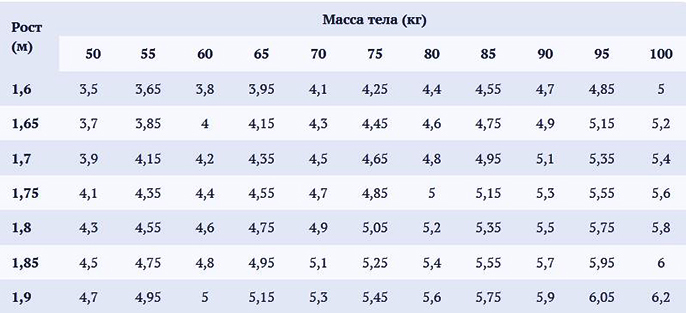
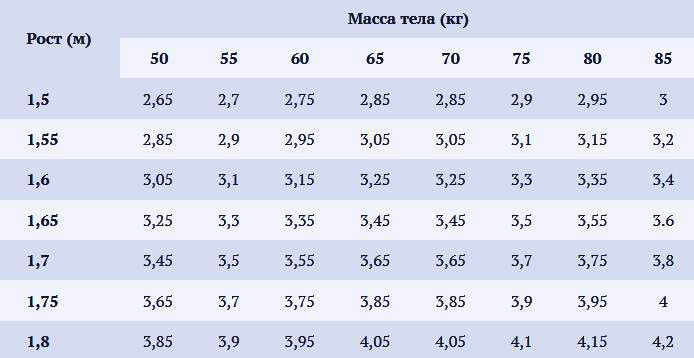
How to measure lung volume
Throughout a person's life, VC changes due to the influence of not only diseases, but also various factors, mainly age-related. A spirometer is used to measure the functional parameters of the pulmonary volume. A special device is used to conduct a ventilation spirometry test.
The design of the spirometer consists of a container with water, in which a float with a counterweight is swinging. The test subject's airways are connected to the airspace of the device using a tube. With active exhalation / inhalation, the float goes down and up, and the amount of air on exhalation and inhalation is judged on a calibrated scale.
Diagnostics allows you to determine the level of functionality of the respiratory system. The test results help to identify the early stage of lung diseases and cardiac pathologies, to assess their severity in order to draw up an adequate treatment program.
The key point is the presence of respiratory diseases, then spirometry is performed twice - without taking the drug and after taking it, in order to evaluate the effectiveness of drug therapy.
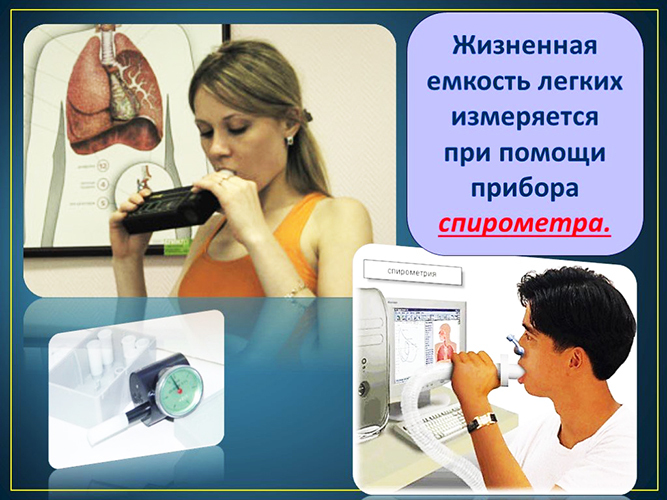
It is important to know that the VC indicator is directly related to the position of the subject's body. If a person is sitting or standing, the difference between the values is negligible. At the same time, in the supine position, a significant decrease in lung capacity is recorded.
How to measure at home
VC (norm for women and men) is checked according to tables with reference (proper) values. A deviation of more than 20% from normal values cannot be considered a pathological condition without the results of in-depth diagnostics.
In a simple way, you can calculate VC by multiplying the growth rate in meters by a factor of 2.5. However, it will be possible to find out the value of your lung volume without spirometry, for this they use improvised means that are easy to find at home.

True, the results obtained will not be highly accurate:
- Balloon. It can be used to measure the value of the tidal volume (TO). To do this, in 30 minutes. before the measurement, you should give up physical activity, calm down and rest. Remove all air from the ball by smoothing it out. Then, after a normal inhalation, exhale all the air inside the balloon. Grasp the end of the object and measure its diameter. The steps should be repeated 3 times to obtain the average value of the diameter of the ball container. To measure the VC indicator, the procedure is repeated along with the preparatory maneuver, but the inhalation / exhalation must be made as deep as possible.
- A fixture with a plastic bottle. After filling a five-liter plastic bottle with water, one end of a rubber hose is immersed in it through a hole made in the lid. Its free end is pinched with a finger to exclude the flow of air. Then the resulting structure is turned upside down and placed in a deep container with water. Now, after an active inhalation, you need to exhale completely into the opening of the hose. The amount of water that will be displaced from the bottle should correspond to the lung volume. To measure VC, you need to turn the bottle over and, using a measuring cup, top up the bottle to the brim, counting the amount of liquid added.
- Confectionery candles. For testing, you will need as many candles as the subject is full years old. Having moved away from the table with candles at a distance of 70-90 cm, you need to blow out all the candle lights with one maximum exhalation. In this way, the strength of the respiratory capacity is determined, as well as the level of ventilation of the pulmonary chambers. The method is not very precise. However, an inability to blow out all the candles at once can be a sign of respiratory distress, which signals a serious illness.
The main causes of violation of VC
In healthy people, the values of individual indicators of VC should correspond to the norm, but for athletes, the parameter can reach 5000-6000 cm3. An excess of more than 30% is not yet considered a pathology.
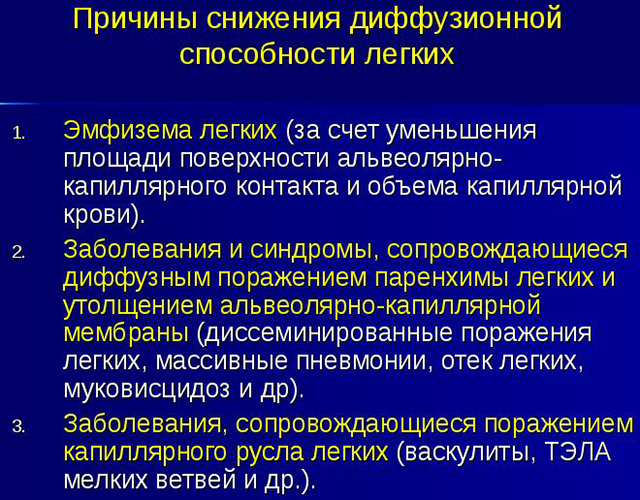
In the case of a decrease in the values of VC, we are talking about the possible development of respiratory failure, which is a symptom of broncho-pulmonary pathologies - pneumonia, obstructive bronchitis, tuberculosis and others diseases.
The reduction process itself can develop according to one of two scenarios:
- OO growth (residual volume). In this case, the reason for the decrease in VC is bronchial obstruction, which is accompanied by the expansion of the broncho-pulmonary structures (bronchi, alveoli). The indicator is not considered a sign of a specific pathology, but is a sufficient reason for an in-depth diagnosis of the entire respiratory system.
- Decrease in TEL (total lung capacity). The reason for the decrease is associated with the compression of the pleural space, which is designed to compress and expand the pulmonary chambers. The pathological condition develops due to a decrease in the volume of tissue structures due to surgery with a complete inability to recover.
If the VC has decreased not for surgical reasons, it is possible to increase it to the normal level with the help of specially designed breathing exercises and certain sports.
To normalize the capacity of the pulmonary space in women, swimming or figure skating will be useful, you can choose race walking, as well as yoga. For men, more extreme options are suitable - rowing, mountaineering or alpine skiing. But it is dangerous to ignore the decrease in lung volume.
Lung vital capacity video
Air volume in the lungs: 6 main concepts:



